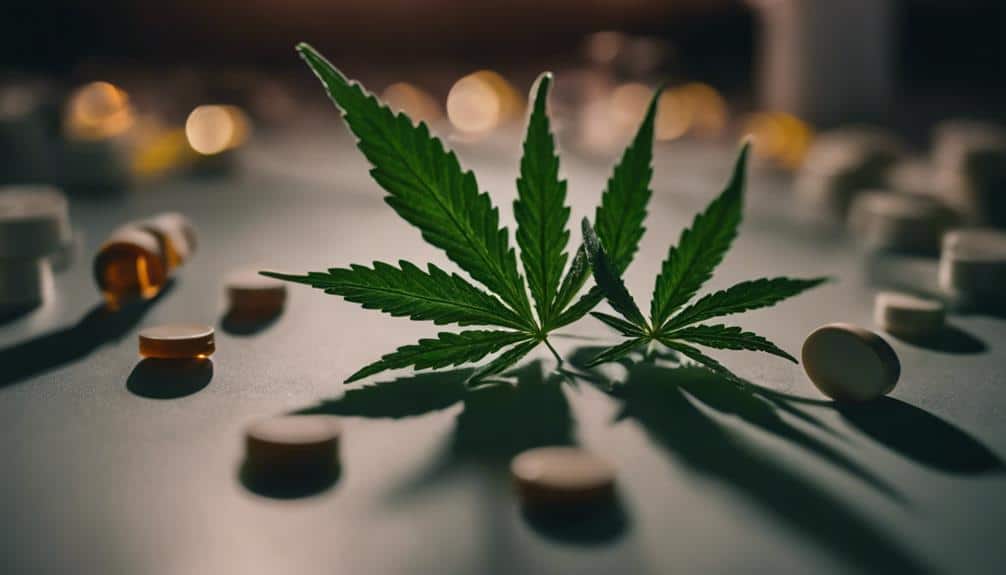Consider the significant paradigm shift that’s potentially on the horizon in the realm of prescription drug use. As cannabis continues to become legal in more states across the U.S., you might be curious about what this means for the future of pharmaceuticals.
Table of Contents
Will people replace pills with pot? Could this transition affect the opioid crisis? These questions aren’t just idle speculation—they’re crucial to understanding what could be a major shift in our healthcare system.
Stay with us, as we’re just beginning to explore this fascinating intersection of law, health, and culture.
The Historical Context of Cannabis Legalization

To truly understand the current state of cannabis legalization, it’s necessary to delve into its historical context. This involves examining shifts in public sentiment, policy changes, and data surrounding its use and regulation over time. You’ll find that prohibition had profound effects that significantly impacted society—effects that still resonate today.
If you analyze the legislative timeline, you’ll see that cannabis was widely used for medicinal purposes in the 19th and early 20th centuries. However, things changed with the Marihuana Tax Act of 1937 which effectively prohibited cannabis use. This set a precedent for further criminalization through laws like the Controlled Substances Act of 1970 which classified cannabis as a Schedule I drug.
Public sentiment began to shift towards decriminalization and medical use by late 20th century. The passage of California’s Compassionate Use Act in 1996 marked the beginning of this change. Today, numerous states have legalized cannabis for medical or recreational use, indicating a reversal of prohibition effects. This evolution reflects changing perspectives towards cannabis and underscores the importance of understanding its historical context.
Legal Cannabis Vs. Prescription Drugs
When considering the impact of legal cannabis on prescription drug use, it’s essential to analyze data and understand potential implications for medical communities, policy makers, and patients.
Legal cannabis and prescription drugs can be viewed as medicinal alternatives—each with their own pros and cons. Let’s delve into some key comparisons:
- Cannabis regulation is often less stringent than that for prescription drugs, increasing accessibility for patients.
- Medicinal cannabis can sometimes offer fewer side effects than certain prescription drugs.
- The potential for addiction varies between legal cannabis and prescription drugs depending on the substance in question.
- Patient costs can differ significantly—with legal cannabis often being more affordable.
- The effectiveness and application of cannabis versus prescription drugs can vary greatly depending on the condition being treated.
In essence, the impact of legalizing cannabis on prescription drug use is multifaceted. It’s vital that healthcare stakeholders continue to educate themselves about these evolving trends.
Moving forward, our focus should always be on improving patient care while ensuring safe and effective medicinal alternatives are available.
The Impact on Opioid Use

When discussing the impact of cannabis legalization, it’s crucial to consider its potential role in curbing opioid use—an issue of significant concern in healthcare today. The legalization of cannabis could be a game-changer in addiction reduction, particularly with opioids.
Recent studies show that states which have legalized cannabis for medicinal purposes experienced a decrease in opioid prescriptions. This suggests that patients are potentially substituting opioids with cannabis for pain management. Consequently, this could lead to a decline in opioid-related addictions and overdoses—a crisis that healthcare providers are undoubtedly concerned about.
However, let’s not jump to conclusions just yet. While this data is promising, there’s still much we don’t know. More comprehensive research is needed to truly understand the long-term effects of this substitution on patients’ health.
We must also consider potential downsides such as whether increased accessibility of cannabis could lead to its own set of addiction problems. It’s a complex issue that requires careful navigation. So while cannabis may be a useful tool in our arsenal, it isn’t a silver bullet. We need to approach it thoughtfully and methodically—always prioritizing patient wellbeing.
Potential Effects on Healthcare Costs
Shifting our focus to the financial aspect, let’s examine how cannabis legalization might affect healthcare costs.
- Insurance Adjustments: Legalization could lead to changes in insurance policies such as reduced prescription drug coverage as more patients switch to cannabis-based treatments.
- Patient Accessibility: Legalization may increase access to alternative treatments potentially reducing reliance on expensive prescription drugs.
- Reduced Hospitalizations: Evidence suggests that states with legal cannabis see fewer hospitalizations related to opioid abuse and overdoses.
- Prescription Drug Costs: With many patients potentially opting for cannabis, pharmaceutical companies might experience decreased sales leading to potential price adjustments.
- Public Health Expenditures: Decreased prescription drug use could lead to less public spending on healthcare.
However, it’s important to note that these potential cost-savings aren’t guaranteed. There are still significant regulatory hurdles for cannabis and the insurance industry’s response remains unpredictable.
Cannabis legalization could also bring about indirect costs such as substance abuse treatments. Therefore, while the potential for cost savings is promising, it requires careful consideration and further study. The financial implications of cannabis legalization are complex and multifaceted—warranting meticulous analysis.
The Future Implications for Prescription Drugs

Looking ahead, it’s clear that the potential ripple effects of cannabis legalization on the prescription drug market could be profound. With increased access to cannabis for medical and recreational use, we might see a shift in public consumption patterns leading to significant changes in the pharmaceutical industry.
We can expect pharmaceutical lobbying efforts aimed at maintaining their market share to become more aggressive and strategic. But remember—it’s not all about competition. This new landscape might also trigger drug innovation leading to more effective and safer treatments.
The integration of cannabis into standard treatment protocols could lead to a decrease in overuse or misuse of certain prescription drugs—particularly opioids. We might see a decline in the number of opioid prescriptions and related overdoses.
Conclusion
So, what’s the bottom line? Cannabis legalization could significantly alter the prescription drug landscape. Fewer opioid prescriptions and potential healthcare cost reductions are strong possibilities. However, it’s crucial to approach this transition methodically using data-driven insights. Could this be the beginning of a major shift in how we approach pain management and healthcare in general? Only time and careful analysis will tell.
If you’re interested in learning more about these potential changes and how they can affect you, we invite you to visit us at Cannabis Docs of Delaware. Our team is always ready to share their knowledge and discuss the benefits and complexities of cannabis legalization. If you have any questions or concerns, don’t hesitate to give us a call. We’re here to help guide you through this evolving landscape with ease. We look forward to speaking with you soon!

